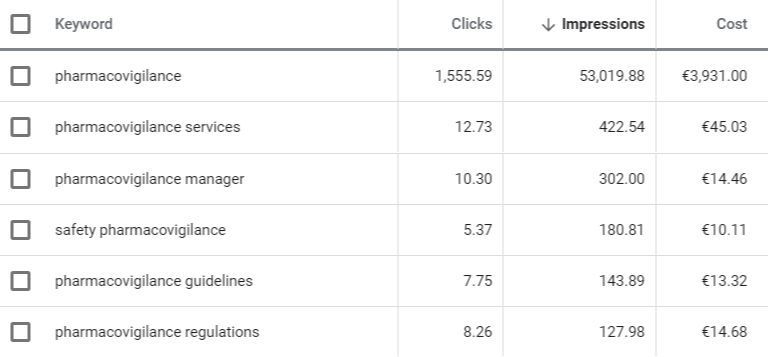Many broadly-focused paid search campaigns struggle to perform amongst stiff competition and audience sizes that far outstrip available budgets, and entire careers are built around cutting through the noise effectively.
But what does a winning strategy look like when an audience pool is small and hard to pin down? It’s a whole different ballgame.

1. Set Realistic Goals
It’s always a good practice to avoid over-promising when launching a new campaign targeted at untested audiences. Inform your client about the challenges the campaign will face. Be upfront and transparent. Let them know that the first month or two is dedicated to speculation, testing and optimizing.
Insider tip: Don’t rely too heavily on Google Keyword Planner. It can be a useful tool for projections but a few outlier keywords can greatly skew the data, especially if your lists include overly broad keywords.

In this example, the too-broad top keyword will artificially increase projections.
Lastly, it’s good to reference account history when it comes to conversions data, but keep in mind that every campaign is unique (variations in keywords, landing page, audience behavior/intent, time of year, etc.) and you won’t truly know how it performs until the data begins to roll in.
2. Prioritize Negative Keywords over Long-Tail Keyword Lists
When facing a challenging campaign, it’s easy to just build out huge keyword lists that include every phrase, match type or possible combination of words, just to make sure that there is nothing missed. But after a week or two, you realize that 90% of your impressions came from 2-3 keywords. While this is not a huge red flag, it can be difficult to manage large keyword sets (and a waste of time and resources in creating them).
A better and more efficient strategy is to better utilize negative keywords, including creating universal negative keywords lists, that can be updated over time by regularly checking the Search Terms results and adding on words as needed. Consider using the strategy below when building your keyword list, starting at steps 1 and 2 and expanding to 3 and 4 if needed.
Target keywords in this order:
 | 1. High Relevance - High Volume |
 | 2. High Relevance - Low Volume |
 | 3. Less Relevance - High Volume |
 | 4. Less Relevance - Low Volume |
Obviously, there are a lot more factors to consider like competition, user intent, and keyword specificity of the search when choosing keywords, but as a rule of thumb this is a generally easy and practical way to approach keyword research.
3. Keep Budgets Fluid
As much as possible, let search volume and results drive your campaign spending. If your campaign is underspending due to low volume but otherwise has a strong CTR, conversion rate, and relevant search terms, don’t panic and take unnecessary risks. Just adjust accordingly.
If you have a set budget to spend but no strict time frame, the best solution is to extend your campaign’s schedule and continue gathering results at your optimized rates. On the other hand, if you have a hard campaign timeline and your back is against the wall, you must expand to higher volume keywords… but how can you improve volume while maintaining high-quality results? The answer is to run ads that target the searcher, not the search.
Ideally, the user will be searching directly for your product or service, but for niche campaigns, this may not be the case. Sometimes they are searching for something similar or adjacent, and your ad copy must be compelling enough to convince them to click on your ad instead.
4. Measure Success Differently
In most stages of the audience journey, Conversions are the most important metric to determine campaign success, but when dealing with lower-volume campaigns with less data and small sample sizes, it can be more difficult to accurately judge keyword success.
An alternate approach to evaluate performance is to implement secondary goals or micro-conversions to determine which keywords are putting you in the best position to be successful. Set up micro-conversions based on post-click performance such as time on site, bounce rate, and pages per session.
Examples of micro-conversions would be:
- Time On Site Spent > 10 Min
- 5 or More Page Views
- Added Product to Cart
- Watched a Video
These metrics will give you a better indication of what keywords are moving visitors down the funnel to achieving your overall business goals, even if they are not converting to your final defined action.
5. Expand to Alternative Mediums or Platforms
If no one is trying to find you, you have to find them. Paid search is a great medium but it doesn’t work if users are not actively searching for what you’re offering.
Consider expanding to paid social, video ads, media placements, display ads, or door to door sales (just kidding on that last one). Your audience is out there, but paid search is not necessarily the best way to reach them.
Quick Recap (or TL;DR)
- Set Realistic Goals. Communicate your challenges; don’t over-promise!
- Keep Budgets Fluid: adjust daily spend as needed, don’t force it!
- Measure Success Differently: focus on post-click performance, utilizing micro-conversions.
- Expand as Needed: Paid search is only one piece of your marketing mix

